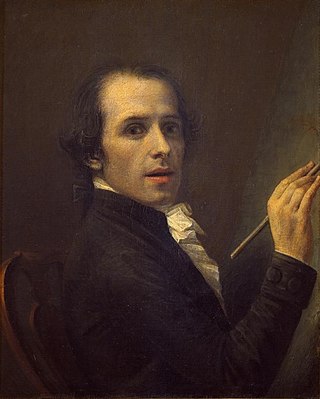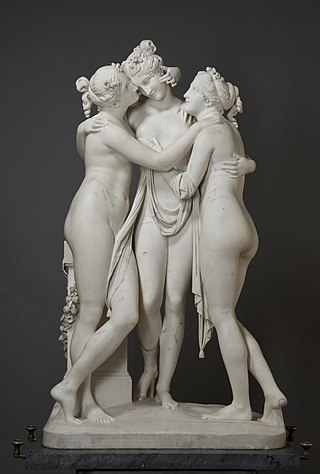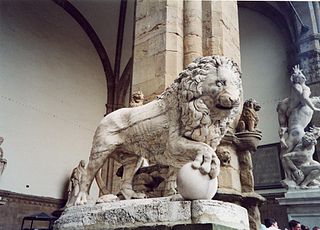
Antonio Canova was an Italian Neoclassical sculptor, famous for his marble sculptures. Often regarded as the greatest of the Neoclassical artists, his sculpture was inspired by the Baroque and the classical revival, and has been characterised as having avoided the melodramatics of the former, and the cold artificiality of the latter.

Giambologna, also known as Jean de Boulogne (French), Jehan Boulongne (Flemish) and Giovanni da Bologna (Italian), was the last significant Italian Renaissance sculptor, with a large workshop producing large and small works in bronze and marble in a late Mannerist style.

Antonio Canova's statue The Three Graces is a Neoclassical sculpture, in marble, of the mythological three Charites, daughters of Zeus – identified on some engravings of the statue as, from left to right, Euphrosyne, Aglaea and Thalia – who were said to represent mirth (Euphrosyne), elegance (Aglaea), and youth/beauty (Thalia).

Lorenzo Bartolini was an Italian sculptor who infused his neoclassicism with a strain of sentimental piety and naturalistic detail, while he drew inspiration from the sculpture of the Florentine Renaissance rather than the overpowering influence of Antonio Canova that circumscribed his Florentine contemporaries.

Pierre Francqueville, generally called Pietro Francavilla, was a Franco-Flemish sculptor trained in Florence, who provided sculpture for Italian and French patrons in the elegant Late Mannerist tradition established by Giambologna.

The Venus de' Medici or Medici Venus is a 1.53 m tall Hellenistic marble sculpture depicting the Greek goddess of love Aphrodite. It is a 1st-century BC marble copy, perhaps made in Athens, of a bronze original Greek sculpture, following the type of the Aphrodite of Knidos, which would have been made by a sculptor in the immediate Praxitelean tradition, perhaps at the end of the century. It has become one of the navigation points by which the progress of the Western classical tradition is traced, the references to it outline the changes of taste and the process of classical scholarship. It is housed in the Uffizi Gallery, Florence, Italy.

Pauline Bonaparte as Venus Victrix is a semi-nude life-size reclining neo-Classical portrait sculpture by the Italian sculptor Antonio Canova. Reviving the ancient Roman artistic traditions of portrayals of mortal individuals in the guise of the gods, and of the beautiful female form reclining on a couch, it was commissioned by Pauline Bonaparte's husband Camillo Borghese and executed in Rome from 1805 to 1808, after the subject's marriage into the Borghese family. It then moved to Camillo's house in Turin, then to Genoa, only arriving in its present home around 1838.

Psyche Revived by Cupid's Kiss is a sculpture by Italian artist Antonio Canova first commissioned in 1787 by Colonel John Campbell. It is regarded as a masterpiece of Neoclassical sculpture, but shows the mythological lovers at a moment of great emotion, characteristic of the emerging movement of Romanticism. It represents the god Cupid in the height of love and tenderness, immediately after awakening the lifeless Psyche with a kiss. The story of Cupid and Psyche is taken from Lucius Apuleius' Latin novel The Golden Ass, and was popular in art.

The Capitoline Venus is a type of statue of Venus, specifically one of several Venus Pudica types, of which several examples exist. The type ultimately derives from the Aphrodite of Cnidus. The Capitoline Venus and her variants are recognisable from the position of the arms—standing after a bath, Venus begins to cover her breasts with her right hand, and her groin with her left hand.

Bertoldo di Giovanni was an Italian Renaissance sculptor and medallist.

Giuseppe Ceracchi, also known as Giuseppe Cirachi, was an Italian sculptor active in a Neoclassic style. He worked in Italy, England, and in the United States following the nation's emergence following the American Revolutionary War.

Villa Carlotta is a villa and botanical garden in Tremezzo on Lake Como in Northern Italy. Today the villa is a museum, whose collection includes works by sculptors such as Antonio Canova, Bertel Thorvaldsen, and Giovanni Migliara; painters such as Francesco Hayez; and furniture pieces of previous owners. The villa, whose architect is unknown, was completed in 1745.

Napoleon as Mars the Peacemaker is a colossal heroic nude statue by the Italian artist Antonio Canova, of Napoleon I of France in the guise of the Roman god Mars. He holds a gilded Nike or Victory standing on an orb in his right hand and a staff in his left. It was produced between 1802 and 1806 and stands 3.45 metres to the raised left hand. Once on display in the Louvre in Paris, it was purchased from Louis XVIII in 1816 by the British government, which granted it to the Duke of Wellington. It is now on display in Robert Adam's stairwell at the Duke's London residence, Apsley House.

The Medici lions are a pair of marble sculptures of lions: one of which is Roman, dating to the 2nd century AD, and the other a 16th-century pendant. By 1598 both were placed at the Villa Medici, Rome. Since 1789 they have been displayed at the Loggia dei Lanzi in Florence. The sculptures depict standing male lions with a sphere or ball under one paw, looking to the side.

The Three Graces is a nearly life-size, figurative Carrara marble outdoor sculpture group located on the historic Oldfields estate on the campus of the Indianapolis Museum of Art (IMA), in Indianapolis, Indiana. The neoclassical marble sculpture depicts the Three Graces, minor goddesses of the Greco-Roman pantheon. The group consists of three women frontally oriented, standing in a row upon a base. The sculpture is modeled after a c. 1797 sculpture by Antonio Canova.

Aristide Petrilli (1868-1930?) was an Italian sculptor active from the late 1800s to early 1900s.

The Palazzo Martelli was a residential palace, and since 2009, a civic museum displaying in situ the remains of the original family's valuable art collection, as well as its frescoed rooms. The palace is located on Via Ferdinando Zannetti 8 near the corner with Via Cerretani in central Florence, region of Tuscany, Italy.
The Pietro Bazzanti and Son Art Gallery is a historic art gallery located in Florence, Italy. Renowned for its craftsmanship of marble, bronze, alabaster, and stone sculptures and mosaics, the gallery specialises in reproductions of Classical, Neo-classical and Renaissance art, while also producing original works by contemporary artists. It has long catered to foreign customers seeking high-quality replicas of masterpieces admired during their travels.

The Museo Canova is a museum established in 1833 at the birthplace of the Italian sculptor Antonio Canova (1757–1822) in Possagno in the province of Treviso in the Veneto, Italy. The museum is dedicated to the life and work of the sculptor and is composed of several parts.




















